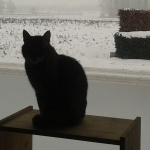http://www.sk.lung.ca/UserFiles/File/Ni ... Winter.pdfThe Sleep Well Project
Ideally people with sleep apnea are diagnosed
by having a test called a polysomnogram
during an overnight visit to a Sleep Lab.
Across Canada access to this very specialized
test varies greatly from province to province.
Here in Saskatchewan people often wait for 2
years to be tested and some people have
waited over 5 years! The new Canadian
Guidelines for Sleep Apnea recommend that
everyone should be tested within 6 months. It
also suggests that for some patients portable
testing equipment could be used to do the
same job that a Sleep Lab now does. The
Saskatchewan government has acted on these
ideas by providing funding through the Lung
Association for a new program called the
Sleep Well Project.
In partnership with the Saskatoon Regional
Health Authority, the Lung Association has
begun home testing of people who
seem likely to have sleep apnea. Once a
diagnosis is made, the client can immediately
attend an education session with the Sleep
Apnea nurse educator at Royal University
Hospital. They use an Auto CPAP machine
for a week to determine the pressure setting
best suited to them. After the initial week the
client is issued a SAIL CPAP machine for
their use. A follow up visit in one month is
also scheduled. Hopefully, the time between
seeing the specialist, getting tested and treated
will be less than 2 months.
There is a screening process for this project
and the patients must be referred by a
Respirologist or other sleep specialist. We
hope that in the future home testing units will
be found in all areas of the province. People
would then be able to pick up the machine
and be tested in their own Health Region.
http://www.canada.com/saskatoonstarphoe ... ccdf3d&p=1Future uncertain for sleep apnea program
Pilot program chops wait list for sleep lab, but funding up in air
Janet French, The StarPhoenix
Published: Monday, November 03, 2008
A pilot project designed to reduce the waiting list for medical sleep tests is on thin ice.
The Sleep Well program is holding its breath while it waits for the Saskatchewan government to decide whether to make it a fully funded program.
Sleep Well is a Saskatoon Health Region project that helps divert patients suspected of having sleep apnea away from Royal University Hospital's sleep lab. As of late September, 2,000 people were on the waiting list for the sleep lab, some of who are waiting up to five years for their tests, said Ruth Anne Appl, a nurse and manager of the sleep disorders centre.
According to the Lung Association of Saskatchewan, Canadian guidelines call for a maximum wait time of two to six months for testing.
Sleep Well, which began in Saskatoon in November 2006, gives up to 12 patients a week the chance to take equipment home to test for the disorder.
In obstructive sleep apnea, a person can stop breathing several times a night, which causes the brain to jolt a person awake to get him or her breathing again. The disorder can cause fatigue and drowsiness, even prompting safety concerns about driving and operating machinery.
The initial test is called polysomnography, which monitors brain activity, heart rate, breathing and more.
If the first test points to sleep apnea, Sleep Well patients then return to meet with a nurse, who sets them up with a continuous positive airway pressure (CPAP) machine and other equipment to take home for seven days. This second test tells health-care workers how much air pressure the patient needs flowing through a mask to keep them breathing normally while asleep.
In Sleep Well, 10 patients come in each week to meet with the nurse and learn about the equipment before taking it home, Appl said.
As a result of the project, more than 80 per cent of Sleep Well clients dodge RUH's sleep lab and its lengthy wait list, Appl said.
Since the project began nearly two years ago Sleep Well has helped reduce the waiting list for sleep lab tests by 20 per cent, she said. The list has shrunk to 2,000 people from 2,500. Wait times for Sleep Well are a matter of weeks.
But there's a problem, says Dr. Robert Skomro, lead physician of the sleep disorders centre.
As long as funding for Sleep Well remains uncertain, he'll have to shut down referrals to the program when it gets busy, then reopen when new dollars roll in.
At first, only respirologists working at RUH could refer patients to Sleep Well. The initial interest was so overwhelming, the program accumulated a three-month waiting list within a year.
Respirologists not based at the university could only refer patients for in-hospital sleep tests or to private operations such as Prairie Oxygen, VitalAire or Medigas, which offer take-home tests for a fee.
By February 2008, unsure if Sleep Well would have funding past March 31, Appl sent a letter to the respirologists shutting down referrals.
"We felt it was inappropriate to continue the program because of the uncertainty of funding," Skomro said.
In May, with another year's funding approved by Saskatchewan Health, Skomro reopened Sleep Well to university referrals and in August said he would accept referrals from all Saskatoon respirologists.
However, business did not pick up when referrals reopened.
Instead of seeing the maximum 12 weekly patients for the initial take home tests, Appl said the staff see between six and eight a week.
The numbers suggest doctors are sending patients for the consistently available private take-home sleep apnea tests rather than to the free public program.
Furthermore, unless the government makes Sleep Well a line item in its budget, the project will continue to be hampered by shut downs and start-ups.
"It's just a matter of time before that happens again," Skomro said.
Its money next runs out in March 2009.
Deb Jordan, executive director of acute and emergency services with the provincial Health Ministry, says the purpose of the Sleep Well project was to determine whether people could be successfully tested for sleep apnea at home rather than heading to the overtaxed sleep lab. That pilot project period was initially supposed to last for six months, not two years.
When asked how much longer the program needs to be in the test phase to be deemed a success, Jordan said she believes the ministry now has all the information it needs.
Sask. Health will now take data gathered in the project and evaluate which patients are suitable for home sleep tests, she said.
Although Regina has its own in-hospital sleep lab, the $260,000-a-year take-home project is only in Saskatoon.
The next step is to get several health regions to meet and answer the question, "What might a home sleep assessment program provincewide look like?" Jordan said.
"There's no doubt there's a patient need," she said. "We need to get the two partners who are already involved in providing sleep assessment around the table and have a discussion about how we best accomplish that."
Even with the Sleep Well program running, Skomro says Saskatchewan has a worrisome shortage of sleep apnea testing available compared to the rest of the country.
He has written a proposal asking the province to expand the publicly funded take-home apnea testing from 12 to 30 patients a week, and for the sleep lab to test 50 patients weekly, up from the current 30 -- this just to serve the northern half of the province.
Senior health region administrators have not yet submitted Skomro's proposal to government, but will soon, according to a spokesperson.
Jordan wouldn't say whether permanent funding or a program expansion is on the table for Sleep Well, or the sleep lab. She said the proposal will be part of the ministry's 2009-10 budget considerations.
I am interested in these articles because I believe:
1)Portable testing will grow rapidly in the U.S.
2)Private enterprises will do a better job than the government.
Johnny Goodman, I hope you get into portable testing very soon and good luck with it.














